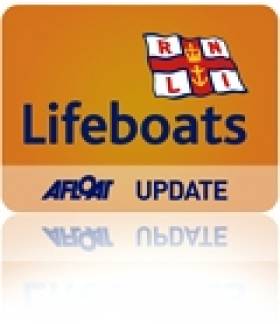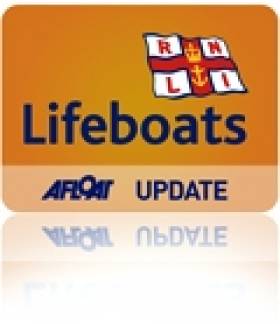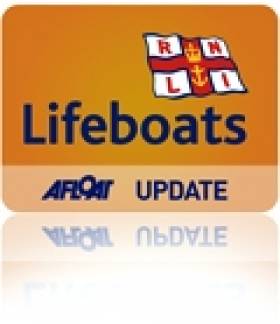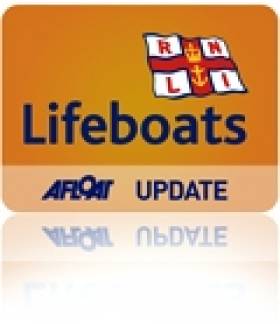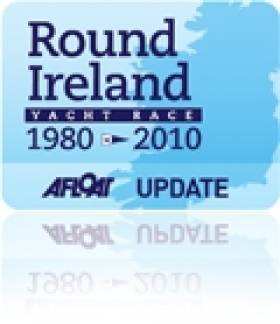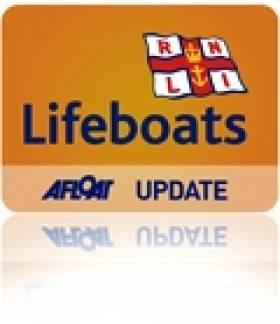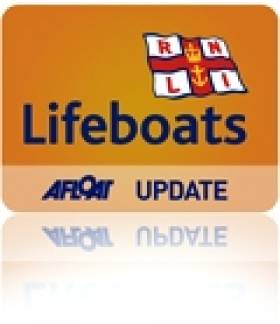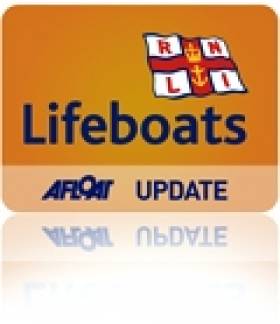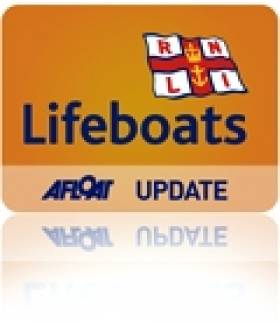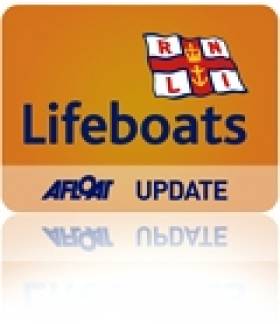Displaying items by tag: RNLI
Members of Ballyglass RNLI responded to an emergency callout yesterday (Sunday 20 June 2010) afternoon for a man reported missing after he went swimming in a remote mountain lake outside Bangor Erris in County Mayo. The volunteer lifeboat crew were unable to take their inshore lifeboat inland to the lake as the location was extremely remote but they are trained in search and rescue techniques and were called on to assist.
The request for help was received by Ballyglass RNLI Coxswain JT Gaughan from the Gardai at 4.10pm yesterday (Sunday 20 June 2010) when the girlfriend of the man reported him missing after he had gone for a swim in Stoney Lake. The mountain lake is three miles from the nearest road and in very rough terrain. The lifeboat crew along with the Gardai, Belmullet Sub Aqua Club, the Coast Guard and members of the North Western Regional fisheries board immediately went to give assistance.
Due to the remote access of the lake the Irish Coast Guard helicopter carried the search and rescue teams as near to the location as it could safely land and a search of the lake commenced. The search was called off at 10.30pm and was resumed first thing this morning. A man was recovered at approximately 10am and pronounced dead at the scene. His body has been taken to Castlebar hospital.
Commenting on the callout Ballyglass RNLI Coxswain JT Gaughan said, "this was a very sad and difficult callout for all involved. Everyone in the community and the various search and rescue agencies worked together in extremely challenging conditions to search for the young man. Our condolences go out to his family and friends."
Man Found Safe and Well
The man whom had been thought missing near Baltimore in West Cork has been located safe and well. All rescue services have been stood down. It is a reminder of the importance of letting people know where you are and where you are going.
Baltimore Lifeboat Search for Missing Man
The RNLI Inshore Lifeboat Bessie was called to assist in a search for a man who failed to make a pre-arranged meeting with a friend in Baltimore yesterday. The man had been camping on the Islands of Roaring Water Bay, and had left his Jeep in Baltimore. When the alert was raised at 20:18, it was unclear where the man might have been intending to stay that night. A search was initiated by Helmsman John Kearney and crewmen Micheal Cottrell and Paul O’Driscoll extending from Barlogue Creek at the mouth of Lough Hyne and into Roaring Water Bay. The Schull inshore lifeboat and the Coast guard helicopter were also involved in the search. The search was stood down last night as darkness fell and recommenced this morning at 05:15 with Helmsman Kieran Collins and crewmen Ronan Sheehy and Jim Baker on board the RNLI inshore lifeboat Bessie.
Both Baltimore Lifeboats Launch on Rescue Missions
Both the all-weather lifeboat and inshore lifeboat based in Baltimore Harbour were called to give assistance on Saturday evening 19th June.
The inshore lifeboat Bessie was called at 18:45 to standby a 58ft motor yacht that was disabled and adrift in Glandore Harbour having hit a rock. Helmsman Youen Jacob assisted by crewmen Kieran Collins and Diarmuid Collins stoody by alongside the Courtmacsherry lifeboat as the motor yacht was towed to safety in Union Hall.
The inshore lifeboat has just been returned to its compound on the pier, when a second alert was raised at 22.25. This time the all-weather lifeboat Hilda Jarrett, responded to a medical emergency on Cape Clear Island. The Public Health Nurse stabilised the casualty prior to the young man being taken on board at North Harbour on Cape Clear Island.. The ambulance service met the lifeboat on its return to Baltimore to transfer the casualty to hospital. The lifeboat was returned to base at 00.10 on Sunday morning. Coxswain Kieran Cotter, was assisted by his crew of Micheal Cottrell, Don O’Donovan, Diarmuid Collins, Brian Ormond, Simon Duggan and John O’Flynn. Remarkably Baltimore lifeboats newest recruit, Diarmuid Collins, attended at both calls.
These two incidents demonstrate the versatility of the RNLI lifeboat capacity at Baltimore. The inshore lifeboat is a twin engine Atlantic 75 RIB, purpose designed for rapid response to inshore emergencies, whilst the larger all-weather lifeboat is suited to long range calls and medical evacuations.
Lifeboat Man Goes Round Ireland
Wicklow RNLI crewmember Brian Sinnott is to compete in the 2010 Round Ireland Yacht Race on Sunday. The lifeboat volunteer is one of 15 young people who will crew the yacht Pride of Wicklow in the race around the Irish coast. Which starts at Midday on Sunday 20th July in Wicklow bay. Lifeboat mascot Stormy Stan joined Brian at the East pier on Thursday evening to wish him the best of luck on behalf of the crew in the 704 mile race.
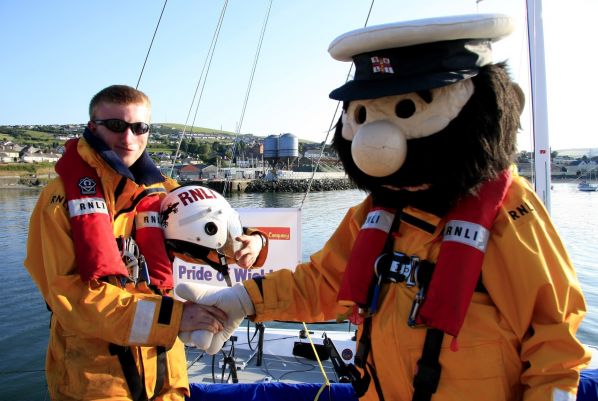
More on the Round Ireland Yacht Race:
Round Ireland Yacht Race 2010 Review
Round Ireland Yacht Race, Ireland's top offshore fixture
A Round up of 80 stories on the 2010 Round Ireland Yacht RaceDun Laoghaire RNLI's New Inshore Lifeboat Gets First Rescue
The incident occurred shortly after 11.00pm when the pair realised their route off the rocky outcrop at Maretimo was cut-off by the incoming tide since their arrival on foot earlier in the day. The location is a scenic though lesser-known beauty-spot that features a disused Victorian-era harbour as well as other derelict structures.
The new IB1-type Inshore Lifeboat (ILB) was replaced the existing D-Class boat at Dun Laoghaire last Thursday and last night's service was the first
for the new boat that features a larger engine, faster speed and improved navigation capabilities.
Man Dragged from Capsized Dinghy at Newtownards Sailing Club
At around 11.45 this morning Belfast Coastguard received an urgent call for assistance to the Newtownards sailing club where four people were in difficulty, two of them children. One man is unconscious, and in a poor way.
An upside down Lazer 2000 dinghy was spotted by a sailing instructor who went to render assistance to those in the water. The crew of a further incoming rigid inflatable boat also helped.
A man in his 50s was then pulled from the water and brought ashore. He is in a very poor way and cardio pulmonary resuscitation has been administered both in the incoming vessel and ashore. The second adult who had been in the upturned dinghy also assisted. Two children who were also in the water are cold, wet and in a state of shock but otherwise unharmed. All four were wearing lifejackets but the lifejacket on the casualty did not inflate.
The Portaferry inshore lifeboats were launched plus the Bangor Coastguard Rescue Team attended. Local police were also in attendance. An ambulance is also on scene.
Rob Steventon, Watch Manager at Belfast Coastguard said
"Along with the Police we are still gathering further details, but we do not know as yet how long the dinghy had been upturned or how long they had been in the water as the first report was by someone who was going out on to the water and had seen the hull of the craft.
"We urge boaters strongly to check their life saving equipment and general safety equipment to ensure everything is working correctly. The Marine Accident Investigation Branch has been informed."
Communion Class visit Wicklow RNLI
Pupils from 2nd Class of Holy Rosary Girls Primary School visited Wicklow RNLI lifeboat Station on Thursday 10th June. They were greeted by some of the volunteer crew and given a tour of the boathouse and the 2 lifeboats on station, they also had the opportunity to try on some of the kit the crew wear and learn about the role of the RNLI in the local community. As the tour concluded teacher Miss Byrne stepped forward to say the girls had recently made their first holy communion and they would like to donate some of the money they received to Wicklow RNLI.
John Hayden who coordinated the visit accepted the donation from the pupils and thanked them for the generous gesture, saying the money would allow the charity to continue saving lives along the Wicklow Coast.
The RNLI Road Show will be in Wicklow during the sail fest weekend, local Sea Safety volunteer Alan Murphy will be available to give free advice on various aspects of safety including lifejacket maintenance. The road show will be located at the RNLI lifeboat Station.
The Annual Wicklow RNLI Model boat day takes place on Sunday 20th June during the Sail Fest , the venue is the South Quay Shed at Wicklow Harbour from 2pm-5pm , all types of model boats and lifeboats will be on display in a indoor pool , this is a free event and all are welcome.

John Hayden of Wicklow RNLI Lifeboat Station accepting the donation from the Holy Rosary pupils - photo RNLI Wicklow
Crosshaven Lifeboat Rescues 18-foot Yacht
Crosshaven RNLI Lifeboat went to the aid of an eighteen foot yacht on passage from the Kinsale area to Crosshaven this evening. The yacht with two persons on board suffered mechanical failure and was having trouble making way into a headwind.
Initially, the yacht was assisted by the motor Cruiser “Callie” who took them on initial tow and informed the Coastguard in Valentia who made the decision to Launch the Crosshaven lifeboat at 7pm. The Volunteer crew made up of Helm Con Crowley with Vincent Fleming and Ritchie Kelleher made their way to the rendezvous between the Cork Bouy and Rennies Point and relieved the motor cruiser of the tow. Crewman Ritchie Kelleher
Boarded the yacht and helped rig the tow for the 40 minute journey back to Crosshaven where the yacht was secured.
Ocean Youth Trust Yacht Lord Rank Sinks off Antrim Coast
The Ocean Youth Trust sail training yacht the Lord Rank sank this morning after hitting rocks off Ballycastle in Co Antrim. Six persons were rescued from the 70-foot ketch in a rescue operation that took just under four hours.
The six, including three Downtown radio presenters, were rescued by lifeboat crews on Tuesday night after hitting rocks near Ballycastle. Those involved were all taking part in a charity fundraiser on board the Lord Rank when the boat ran aground off Kinbane Head shortly after 2200 BST.Downtown Radio was broadcasting from the boat as part of the charity campaign. The six were landed at Ballycastle with no injuries. The Sligo based Irish Coast Guard helicopter also responded to the callout.
Five of the group were taken off the yacht by the Portrush RNLI lifeboat, which launched its Y boat to recover them. The Red Bay RNLI Atlantic inshore lifeboat took the sixth person off before transferring them to the Portrush lifeboat, which then brought them in to Ballycastle.
Paddy McLaughlin, Red Bay RNLI helm said, “ Both Red Bay and Portrush RNLI lifeboats responded to the callout. Our priority was to get everyone off the stranded vessel as quickly as possible as it had hit rocks and the damage to the vessel was not known. That area has a strong tide and we wanted to ensure the safety of the skipper and the five passengers.”The vessel sank a few hours later.
The Lord Rank was Ireland's only operational sail training vessel of any size since the Asgard II sank off the coast of France in 2008.
The BBC article on the sinking is HERE, while the RNLI report of the incident is HERE.


























